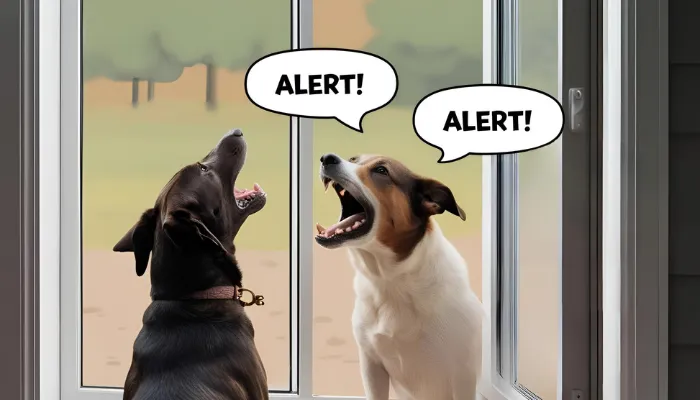What Is Sorry in Dog Language? Even without vocabulary, dogs have various ways to convey different feelings whether it is guilt or regret. Their body movements, actions, and even facial expressions act as dog translators for people wishing to comprehend their dog’s feelings. If your dog has erred somewhere, you might witness certain actions that imitate saying sorry. But how can you be sure? Let’s examine how dogs show remorse in emotion and how to do more to foster reaching your bond with them.

How Do Dogs Show Apology?
Dogs do not carry the burden of guilt along the same lines as humans do, but they do react to some human feelings. Here are a few ways that dogs manifest when attempting to imply sorry:
- Head Dropped – Lowering their head is simply a show of submission.
- Avoid Direct Eye Contact – Eye contact is often the first thing to go when a dog looks guilty.
- Tucked Tail – Their tail may be low or between their legs.
- Licking or Nudging You – Some dogs use licking as an apology.
- Pawing at You – They may gently place a paw on you to seek forgiveness.
Understanding what is sorry in dog language helps decode their subtle gestures. Their body language speaks louder than words.
The Science Behind Dog Apologies
Apologies in dogs stem from the fact that their emotions stem primarily from humans. When a dog lowers its body or appears to feel sorry, it is solely dependent on the owner’s voice or actions. Scientists have concluded that dogs do not experience guilt, but rather sadness in response to their owners’ disappointment. Between the two emotions, the dog’s sadness is brought forth due to it perceiving its owner’s feeling of sadness.
Do Dogs Understand When They Do Something Wrong?
It goes both ways. They understand routines and consequences but do not understand the reasoning behind being yelled at or scolded until it is too late.
How to Recognize a Dog’s Apology?
- Watch their body language closely.
- Observe if they seek physical contact after a scolding.
- Notice changes in tail and ear position.
Recognizing what is sorry in dog language starts with understanding their body language. Their reactions mirror your emotions more than guilt.
Dog Apology vs. Human Apology
Dogs and humans apologize in different ways, but their intent remains the same. Understanding these differences helps decode what is sorry in dog language.
| Behavior | Dog’s Way | Human’s Way |
|---|---|---|
| Saying Sorry | Lowering head, licking, nudging | Verbal expression |
| Seeking Forgiveness | Rolling over, exposing belly | Offering apologies |
| Understanding Guilt | Reacting to owner’s voice | Feeling emotional guilt |
The way dogs express what is sorry in dog language relies on actions, not words. Their gestures reflect submission and a desire to mend bonds.
Can You Teach a Dog to Say Sorry?
Dogs do not literally say sorry, but you can train them to behave in ways that show regret.
3 Steps to Train a Dog to Apologize
- Use Consistent Commands – Say “No” in a firm tone when they make a mistake.
- Reward Good Behavior – Reinforce positive actions with treats or affection.
- Encourage Gentle Gestures – Teach them to offer a paw or nuzzle after a mistake.
Teaching a dog to apologize is about guiding their actions, not words. Consistent training helps them associate gestures with making amends. Their way of saying sorry strengthens your bond.
Why Do Dogs Act Guilty?
Many dogs show guilty behavior because they associate certain situations with punishment. If they have been scolded in the past, they might react in a similar way the next time something goes wrong.
Signs of a “Guilty” Dog
- Crouching or slinking away
- Rolling onto their back
- Avoiding their owner
- Sudden quietness
A dog’s guilty look reflects learned behavior, not true remorse. Understanding what is sorry in dog language helps interpret their reactions better.
How Should You React?
Dogs respond best to guidance, not punishment. The right reaction shapes their behavior without causing fear.
- Stay Calm – Yelling confuses your dog.
- Use a Firm Tone – A clear “No” is more effective than shouting.
- Reward Good Behavior – Reinforce positive actions instead of focusing on guilt.
Clear communication builds trust and understanding. A calm approach strengthens your bond and encourages better behavior.
FAQs About Dog Apologies
Dogs communicate apologies through body language rather than words. Understanding their signals helps strengthen your connection.
1. How Do Dogs Say Sorry?
Dogs use body language like lowered ears and licking to show regret.
2. Do All Dogs Say Sorry the Same Way?
No, different breeds and personalities may express “sorry” differently.
3. Should You Punish a Dog for Being “Guilty”?
No, Term guilt is misplaced when dealing with dogs and punishment should not be towards emotional or construct guilt.
A dog’s way of saying sorry is subtle but meaningful. Recognizing their cues deepens your bond and improves communication.
Conclusion
What Is Sorry in Dog Language? Dogs show regret with facial expressions alongside words and pair bowing, teeth bearing with eager physical contact. Dogs are not capable of feeling guilt but are influenced by humans moods. How you interpret your dog’s apology will deepen your relationship with him and enhance how well he is understood.
The next time you notice your dog looking guilty, know that they are merely responding to your feelings, not feeling regretful.
By recognizing how dogs communicate, you can better understand their emotions and responses.
